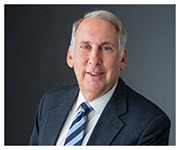New York Medical College and Touro College and University System Host Third COVID-19 Symposium
The Next Phase of Clinical and Public Health Management

Having established itself as one of the State’s leading thought leaders on the COVID-19 health crisis, the Center for Disaster Medicine (CDM) at New York Medical College (NYMC) and the Touro College and University System (TCUS) co-hosted the third COVID-19 Symposium via a webinar on May 6. Alan Kadish M.D., president of TCUS welcomed the virtual audience of more than 500 students and faculty, doctors, public health professionals and the press, who tuned in to the symposium, “The Next Phase of Clinical and Public Health Management.” Moderated by Edward C. Halperin, M.D., M.A., chancellor and chief executive officer at NYMC, the event brought together a panel of experts from TCUS and NYMC to both shed light on what we have learned over the past few months and provide their expert insights into the next steps amidst the COVID-19 crisis.
Shekhar Bakshi, D.V.M., Ph.D., associate professor of microbiology and immunology, kicked off the panel of experts providing an in-depth overview of the knowledge gleaned in laboratories over the past five months about the basic science of the virus and immune response. “However, the role of antibodies in protection, duration of immunity and resistance from subsequent infection has not yet been established,” Dr. Bakshi cautioned.
Next, Janet Piscitelli, M.D., director of pathology and laboratory services at Westchester Medical Center Health Networks discussed the complexities of antibody testing for SARS-CoV-2, the virus responsible for the COVID-19 pandemic. “After exposure to the virus SARS-CoV-2, the body fights the infection by mounting an immune response to the pathogen. Some of these antibodies are specific to COVID-19 and can be detected in the serum and plasma in the blood of the person several days after infection. The use of serologic tests measure antibodies rather than detecting the virus itself—may help in determining the actual numbers of persons infected with SARS-CoV-2,” said Dr. Piscitelli explained. She also highlighted the challenges with COVID-19 antibody testing, s a direct result of lack of consistency between the various (proprietary) assays and the rush to market by test manufacturers, which resulted in questionable quality with respect to sensitivity and specificity. Ending on a positive note, she said, “On May 4, the FDA issued new guidelines requiring the companies that develop these assays to provide full validation with documentation submitted to the FDA within 10 days. Hopefully, this will curtail the distribution of problematic tests.”
“In public health emergencies like this one – information is key,” said Robert Amler, M.D., M.B.A., dean of the School of Health Sciences and Practice and vice president of government affairs, who was tapped for the symposium to speak about what data is useful and how we can interpret that data to make decisions about reopening the economy. “At the Center for Disaster Medicine at NYMC, we deal with community-wide emergencies with biological roots (like our current epidemic), chemical spills, explosive events, and even active shooting,” he explains. “Why bring this up – because in all of these types of emergencies, information key, but the information is not the same as data.” According to Dr. Amler, in considering the data in the context of this pandemic (or any emergency), we are often overloaded with data that may actually provide little usable info. “ The current example—in the news every day we are given the number of infections, the number of cases, the number of deaths – but we get far less information about the rates. It’s only by understanding rates that we can make a fair comparison.” Dr. Amler concluded, “When thinking about reopening, we will need to focus on what we are learning about testing— and focus our ability to interpret results.”
Marisa Montecalvo, M.D., infectious disease specialist and professor of medicine at NYMC pointed lessons from Wuhan and the initial outbreak in a Seattle-based long-term care facility. “Three issues have become clear – unlike in the previous SARS virus, pre-symptomatic or asymptomatic transmission can occur in which there are high viral loads, even before patients are symptomatic,” she said. “One of the most worrisome parts of controlling COVID-19 and going back to work is that we will not be able to let our guard down since we will not know who could have had COVID-19 transmitted to them and who could be subsequently developing symptoms.”
Finally, Sherlita Amler, M.D., M.S., commissioner of health for Westchester County, provided insight into the next phase of the public health response to COVID-19. “Here in Westchester, we are entering a downward trend, seeing fewer cases of COVID-19 each day, fewer hospitalizations, fewer deaths overall, and fewer people asking to be tested. As the State begins to relax some restrictions, the next challenge will be active surveillance—as people come out of their homes and go back to work and to school, we will need to recognize any new source of transmission that emerges and to react quickly,” she said.
Dr. Kadish concluded the symposium saying, “We’ve learned a lot, but we have not learned enough. Other than social interventions including social distancing, hand washing, using disinfectants, and wearing masks, we have not learned enough about dramatic interventions to combat COVID-19.”
